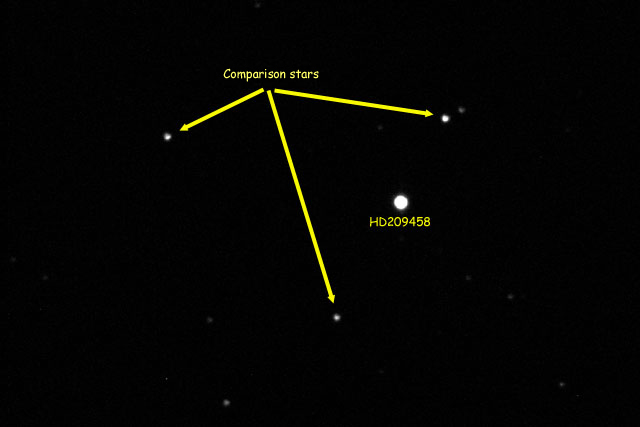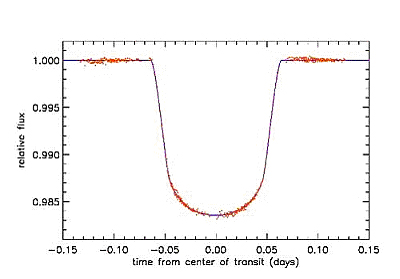
For all the images : C14, ST8, exposure time = 20 s, with green filter, total field : 12 X 8 ', very bad seeing.
"Exoplanets and differential photometry"
realized with graduate
students of SupOptique
(in
connection with our
observatory)
The exoplanets are planets which orbit around other stars than the Sun.
To detect them directly, it is necessary to be able to solve the 2 major following difficulties.The star which is the subject of this work is HD209458 . It is located in the constellation Pegasus, at 150 light years away, and its spectral type is very close to that of our Sun. A few years ago, astronomers discovered by Doppler effect a Jupiter-type planet in its vicinity. In 1999, this exoplanet was rediscovered by the method of the transit : every three days and a half, this planet eclipses its star during approximately three hours, inducing a fall of its flux close to 1.6 % !!!
The goal of this project is to get the transit curve of this couple. We thus need to carry out extremely precise photometric measurements, that, to date, only few amateurs in the world succeeded in (see the site of the network transitsearch for more information).
After many attempts, we could finally
image HD209458 on december 1, 2004.
The predicted transit epochs (UT) were as follows : begin at 16h09, center at 17h50,
end at 19h30.
The Sunset was at 16h00, therefore the twilight prevented us to see the
beginning of the transit. We thus decided to concentrate on the end of the
transit, by taking 70 images between 18h33 and 19h39 (UT).
Here is an example of preprocessed image of HD209458, surrounded by 3 comparison
stars :

For all the images : C14,
ST8, exposure time = 20 s, with green filter, total field : 12 X 8 ', very bad seeing.
HD209458 has a magnitude of 7.65. The comparison stars have magnitudes ranging between
11.2 and 11.6.
The photometric processing of the 70 images was made with IRIS . We used 2 methods : aperture photometry and the function called PSF, the latter having given us the best results.
Here is the curve of the relative variation of flux of HD209458, versus time :

HD209458b : End of transit (just
after the twilight).
The first exoplanet detected from our observatory.
Data from HST are drawn from the
curve below.
The model is based on a small black disc which passes in front of the star. The
latter is
supposed to have a uniform brightness.
Please note that we plotted raw data (no averaging, no filtering).
It seems that the end of the transit is well detected.
The measured transit depth is
approximately 1.6 %, close to the value measured by HST :

Transit of HD209458b seen by HST.
It would have been preferable to measure all the
transit, like Hubble.
Nevertheless, this is a first step for us, even if it is really hard to measure a relative
variation of flux smaller than 2 %, on an 8 mag star.
We learned a lot doing this first transit and we have already some ideas to get better
results.
See you in a few weeks with
TrES-1...Stay
tuned !
To join us :